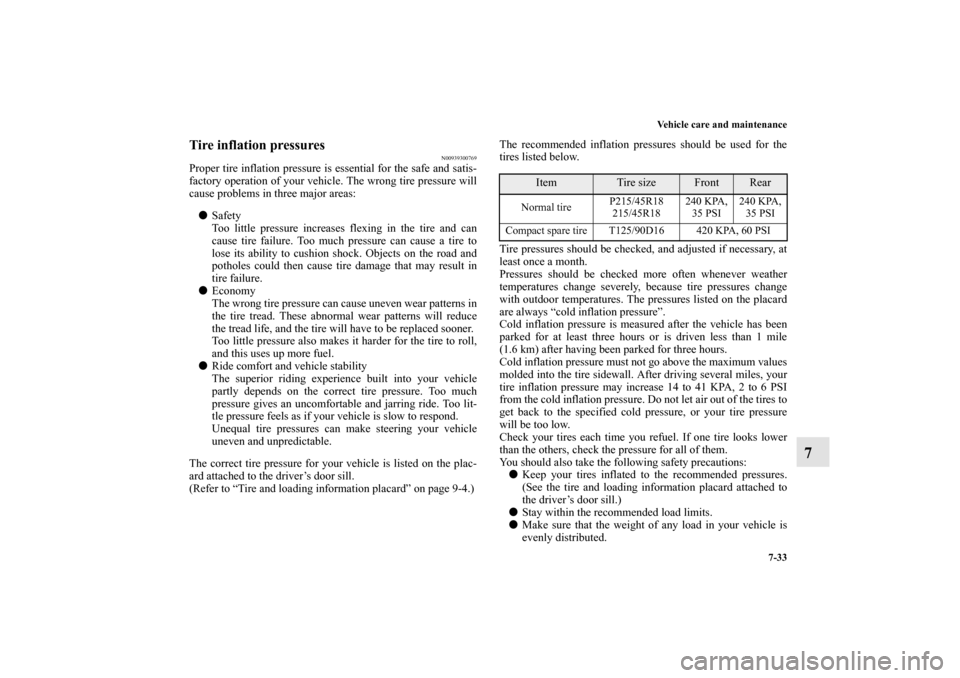Page 564 of 658

Vehicle care and maintenance
7-33
7
Tire inflation pressures
N00939300769
Proper tire inflation pressure is essential for the safe and satis-
factory operation of your vehicle. The wrong tire pressure will
cause problems in three major areas:�
Safety
Too little pressure increases flexing in the tire and can
cause tire failure. Too much pressure can cause a tire to
lose its ability to cushion shock. Objects on the road and
potholes could then cause tire damage that may result in
tire failure.
�
Economy
The wrong tire pressure can cause uneven wear patterns in
the tire tread. These abnormal wear patterns will reduce
the tread life, and the tire will have to be replaced sooner.
Too little pressure also makes it harder for the tire to roll,
and this uses up more fuel.
�
Ride comfort and vehicle stability
The superior riding experience built into your vehicle
partly depends on the correct tire pressure. Too much
pressure gives an uncomfortable and jarring ride. Too lit-
tle pressure feels as if your vehicle is slow to respond.
Unequal tire pressures can make steering your vehicle
uneven and unpredictable.
The correct tire pressure for your vehicle is listed on the plac-
ard attached to the driver’s door sill.
(Refer to “Tire and loading information placard” on page 9-4.)The recommended inflation pressures should be used for the
tires listed below.
Tire pressures should be checked, and adjusted if necessary, at
least once a month.
Pressures should be checked more often whenever weather
temperatures change severely, because tire pressures change
with outdoor temperatures. The pressures listed on the placard
are always “cold inflation pressure”.
Cold inflation pressure is measured after the vehicle has been
parked for at least three hours or is driven less than 1 mile
(1.6 km) after having been parked for three hours.
Cold inflation pressure must not go above the maximum values
molded into the tire sidewall. After driving several miles, your
tire inflation pressure may increase 14 to 41 KPA, 2 to 6 PSI
from the cold inflation pressure. Do not let air out of the tires to
get back to the specified cold pressure, or your tire pressure
will be too low.
Check your tires each time you refuel. If one tire looks lower
than the others, check the pressure for all of them.
You should also take the following safety precautions:
�
Keep your tires inflated to the recommended pressures.
(See the tire and loading information placard attached to
the driver’s door sill.)
�
Stay within the recommended load limits.
�
Make sure that the weight of any load in your vehicle is
evenly distributed.
Item
Tire size
Front
Rear
Normal tireP215/45R18
215/45R18240 KPA,
35 PSI240 KPA,
35 PSI
Compact spare tire T125/90D16 420 KPA, 60 PSI
BK0103001US.book 33 ページ 2009年8月20日 木曜日 午前10時45分
Page 577 of 658

7-46 Vehicle care and maintenance
7
Exhaust system
N00942200108
The best way to keep carbon monoxide gas from entering
inside your vehicle is to have the engine exhaust system prop-
erly serviced.
Have a competent mechanic inspect the complete exhaust sys-
tem and nearby body areas for broken, damaged, deteriorated,
or mispositioned parts if you notice any of the following:�
A change in the sound of the exhaust system
�
The smell of exhaust fumes inside the vehicle
�
The underside or rear of the vehicle is damaged
Also check the exhaust system each time the vehicle is raised
for lubrication, oil changes, or required service. Any open
seams or loose connections could let dangerous exhaust fumes
seep into the luggage compartment and passenger compart-
ments.
Check for any of the following conditions: �
Check for holes or exhaust gas leaks caused by corrosion
or damage.
�
Check the joints and connections for looseness or exhaust
gas leaks.
�
Check the rubber hangers and brackets for damage.
Hood lock release mechanism and safety catch
N00942500114
The hood lock release mechanism and hood safety catch should
be checked, cleaned, and oiled when needed for easy move-
ment and to stop rust and wear. Use Multipurpose Grease
NLGI Grade 2 sparingly for all sliding parts of the hood latch
and release lever. Work the grease into the hood lock mecha-
nism until all the movable surfaces are covered.
Also, put a light coat of the same grease on the safety catch
wherever moving parts touch.
WA R N I N G
!�
Carbon monoxide gas from your vehicle’s exhaust is
poisonous. Breathing these fumes can cause uncon-
sciousness or death.
BK0103001US.book 46 ページ 2009年8月20日 木曜日 午前10時45分
Page 651 of 658

Alphabetical index
2Card holder 3-274
Cargo floor boxes 3-288
Cargo loads 4-12
Cargo room light
Bulb capacity 7-61
Replacement 7-91
Switch 3-283
Catalytic converter 7-3
Certification label 9-5
Charging system warning light 3-216
Chassis number 9-3
Child restraint 2-25
Child safety locks for rear door 3-58
Cigarette lighter 3-276
Cleaning
Inside of your vehicle 7-93
Outside of your vehicle 7-94
Clutch
Fluid 7-21
,9-10
Pedal free play 7-39
Coat hooks 3-293
Combination headlights and dimmer switch 3-220
Consumer information 8-2
Continuously variable transmission (CVT) 3-93
Fluid 7-17,9-10
Selector lever operation 3-94
Sports mode 3-100
Coolant (engine) 7-11
,9-10
Cruise control 3-144Cup holder 3-288
D
Daytime running lights
Bulb capacity 7-58
Replacement 7-66
Defogger (rear window) 3-240
Defrosting or defogging (windshield, door windows) 5-14
,5-
24
Digital clock 5-99
Dimensions 9-6
Dimmer (high/low beam change) 3-224
Disc brake pads 7-44
Dome light (rear)
Bulb capacity 7-61
Replacement 7-90
Switch 3-281
Dome light/Reading lights
Bulb capacity 7-61
Replacement 7-88
Switch 3-279
Doors
Lock 3-53
Power door locks 3-56
Drive belt 7-45
Driving during cold weather 4-5
Driving, alcohol and drugs 4-2
Dual height adjustable cargo floor board 3-291
BK0103001US.book 2 ページ 2009年8月20日 木曜日 午前10時45分